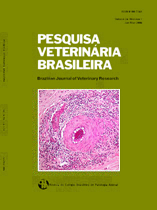 |
|
|
|
Year 2012 - Volume 32, Number 6
|

|
Characterization of Cysticercus bovis lesions at postmortem inspection of cattle by gross examination, histopathology and polymerase chain reaction (PCR), 32(6):477-484
|
ABSTRACT.- Costa R.F.R., Santos I.F., Santana A.P., Tortelly R., Nascimento E.R., Fukuda R.T., Carvalho E.C.Q. & Menezes R.C. 2012. [Characterization of Cysticercus bovis lesions at postmortem inspection of cattle by gross examination, histopathology and polymerase chain reaction (PCR).] Caracterização das lesões por Cysticercus bovis, na inspeção post mortem de bovinos, pelos exames macroscópico, histopatológico e pela reação em cadeia da polimerase (PCR). Pesquisa Veterinária Brasileira 32(6):477-484. Departamento de Saúde Coletiva Veterinária e Saúde Pública, Faculdade de Veterinária, Universidade Federal Fluminense, Rua Vital Brazil Filho 64, Santa Rosa, Niterói, RJ 24230-340, Brazil. E-mail: rrfalcosta@yahoo.com.br
Considering the importance of improving methods for diagnosis of bovine Cysticercosis, this study aimed to verify Cysticercus bovis occurrence in different anatomical sites, as head, heart, esophagus, diaphragm, tongue, liver and carcass, examined by federal inspection service. Diagnosis was performed by gross examination, histopatholgy and PCR with boiling DNA extraction for metacestode identification. Of 22043 slaughtered cattle, 713 (3.23%) were infected. The heart was mostly affected with 1.90% (420/22043), followed by head, 1.11% (245/22043), esophagus, 0.08% (18/22043), carcass, 0.07% (15/22043), diaphragm, 0.03% (7/22043), liver, 0.02% (5/22043) and tongue, 0.01% (3/22043). Of the cysts obtained, 58.35% (416/713) were dead and 41.65% (297/713) were alive. The differences among anatomical sites and cysts status were significant (p<0.05). Of the 416 dead cysts 253, characterized by nodular firm whitish lesions, containing yellowish material, some times in calcareous aspect were examined for histopathology. The histological exams of these cysts yielded granulomatous lesions, whose centers were characterized by caseous and/or calcareous material, multinucleate giant cells, histiocytes in palisade and infiltrate composed predominantly by lymphoid cells, wrapped up by fibrosis. Some times the lesions peripheries had granulation tissue and mineralized areas, like linear blade. The parasite debris were like a hyaline, non cellular material with spherical and ovoid, basophilic, eosinophilic and colorless corpuscles. These corpuscles were seen rarely, some times, among inflammatory reaction. Fibrous nodules, rich in lymphoid or mixed infiltrates, were frequently seen. Of the live cysts subjected to PCR with boiling DNA extraction, 65% (13/20) were positive for C. bovis, confirming the ambulatory diagnosis and the efficacy of the PCR procedure used. Due to microscopic and PCR diagnostic exams of C. bovis, mainly in the liver and esophagus, it is suggested changes in the 176 article of the regulatory inspection, by including these sites in the bovine routine inspection at the slaughterhouses. |
| |
|
|
| |
|
 |